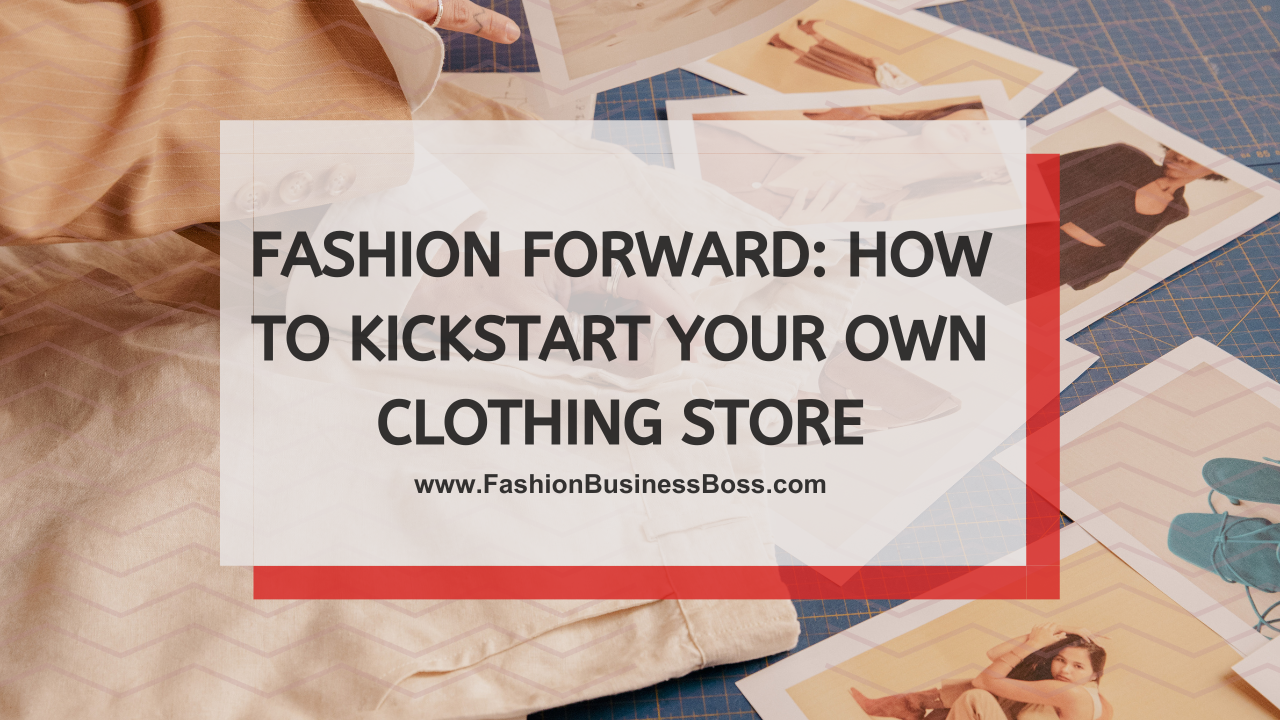Starting a clothing store can be an exciting and rewarding venture for those with a passion for fashion and retail. However, like any business, it requires careful planning, market research, and strategic execution to ensure long-term success.
To start a clothing store, define your brand identity, conduct thorough market research, create a solid business plan, source quality inventory, establish an online presence, and prioritize exceptional customer experiences.
I. Defining Your Brand Identity
Before diving into the practical aspects, it’s crucial to establish a clear brand identity that will differentiate your clothing store in the market. Consider the following factors:
1. Target Audience:
Identifying your target audience is crucial for the success of your clothing store. Start by conducting market research to gain insights into the demographics, preferences, and lifestyle of your potential customers. Consider factors such as age, gender, occupation, geographic location, and income level. Understanding their style preferences, fashion influences, and shopping behaviors is equally important. This knowledge will guide your product selection, pricing, and marketing efforts.
For example, if your target audience consists of young, fashion-forward individuals, focus on trendy and edgy clothing options. If you’re targeting professionals, offer sophisticated and elegant attire suitable for the workplace. Tailor your marketing messages and channels to resonate with your audience’s interests and preferences. By catering to their specific needs, you can build a loyal customer base and create a personalized shopping experience that sets your clothing store apart from competitors.
2. Unique Selling Proposition (USP):
To differentiate your clothing store from competitors, you need a compelling Unique Selling Proposition (USP). Determine what makes your store unique and communicate it effectively to your target audience. Your USP could be based on various factors, such as offering eco-friendly materials, providing affordable luxury clothing, or delivering personalized styling services.
For example, if you focus on sustainability, emphasize your use of organic fabrics, recycled materials, or ethical manufacturing practices. If affordability is your USP, offer high-quality garments at competitive prices. Alternatively, if personalized styling is your strength, provide one-on-one consultations, outfit recommendations, or customized styling services.
By identifying and emphasizing your USP, you create a distinct value proposition that attracts customers who align with your brand’s values and offerings. This unique positioning helps establish your clothing store as a go-to destination for customers seeking a specific experience or benefit.
3. Brand Personality:
Defining your brand’s personality is essential for shaping your clothing store’s identity and attracting the right customer base. Consider the emotions and values you want your brand to evoke. Is it sophisticated and elegant, or edgy and urban? Is it youthful and vibrant or timeless and classic? Your brand personality will influence your store’s aesthetics, tone of voice, and overall customer experience.
For instance, if you aim for a sophisticated and elegant brand personality, focus on creating a refined store atmosphere, elegant packaging, and using sophisticated language in your marketing materials. On the other hand, if you want to project an edgy and urban image, opt for a modern store design, trendy product offerings, and a more casual and contemporary tone in your communication.
Consistency is key in maintaining your brand personality across all touchpoints, including your website, social media, and customer interactions. By crafting a strong brand personality, you create a unique identity that resonates with your target audience, helps establish brand loyalty, and sets your clothing store apart in a crowded market.
II. Conducting Market Research
Thorough market research will provide valuable insights into the competitive landscape, consumer trends, and demand for your clothing store. Consider the following steps:
1. Competitor Analysis:
Conducting a thorough competitor analysis is vital when starting a clothing store. Identify and analyze both direct and indirect competitors operating in your target market. Study their product offerings, pricing strategies, marketing tactics, and customer reviews. This research will provide valuable insights into the strengths and weaknesses of your competitors, allowing you to identify gaps and opportunities in the market.
By understanding your competitors’ product ranges, you can determine how to differentiate your offerings and provide unique value to customers. Analyzing their pricing strategies helps you position your prices competitively. Additionally, studying their marketing tactics and customer reviews enables you to learn from their successes and shortcomings, refining your own marketing approach.
2. Target Market Analysis:
Evaluating your target market is crucial for understanding your potential customers. Assess the size, demographics, preferences, and purchasing power of your target audience. Gain insights into their shopping behaviors, fashion influences, and brand affinities. This information will guide your inventory selection, product development, and marketing strategies.
By understanding your target market’s preferences, you can curate a collection of clothing items that align with their tastes and style. Knowing their shopping behaviors helps determine whether they prefer online or in-store experiences and how to tailor your customer service accordingly. Understanding their brand affinities enables you to position your clothing store in a way that resonates with their values and preferences, creating a strong connection with your target audience.
3. Location Analysis:
If you plan to open a physical store, conducting a thorough location analysis is crucial. Assess potential locations based on factors such as foot traffic, accessibility, proximity to your target audience, and competition. A high-traffic area with your desired customer demographic nearby is ideal. Analyze the local competition to avoid saturation and identify opportunities for differentiation.
For an online store, focus on website design, user experience, and search engine optimization (SEO) strategies. Your website should be visually appealing, user-friendly, and optimized for search engines to drive organic traffic. Implementing effective SEO techniques will help improve your online visibility and attract potential customers.
By carefully analyzing potential locations or optimizing your online presence, you position your clothing store for success by reaching the right audience and providing convenient access to your products and services.
III. Creating a Business Plan

A well-structured business plan will serve as a roadmap for your clothing store’s success. Consider the following elements:
1. Executive Summary:
The executive summary of your clothing store business plan provides a concise overview of your business. It should encapsulate your mission, vision, target market, and unique selling proposition (USP). Clearly communicate the essence of your brand and what sets it apart from competitors.
Share your mission statement, which defines the purpose and values of your clothing store. Articulate your vision for the future, outlining your long-term goals and aspirations. Clearly define your target market, including demographics, preferences, and lifestyle characteristics.
Highlight your unique selling proposition, emphasizing the key factors that differentiate your clothing store. Whether it’s sustainable materials, affordable luxury, or personalized styling services, clearly communicate why customers should choose your store over competitors. This section should capture the essence of your business and provide an enticing introduction to potential investors, partners, or stakeholders.
2. Market Analysis:
In the market analysis section, summarize the findings from your comprehensive market research. Include a competitive analysis, evaluating both direct and indirect competitors. Identify their product offerings, pricing strategies, marketing tactics, and customer reviews. Assess their strengths and weaknesses to identify opportunities for your clothing store.
Provide insights into your target market, including the size, demographics, and psychographics. Highlight their shopping behaviors, fashion influences, and brand affinities. Explain how your clothing store aligns with their preferences and needs.
Summarize any market trends or shifts that may impact the clothing industry, such as sustainability concerns or changing consumer behaviors. This section demonstrates your understanding of the market landscape and positions your clothing store to capitalize on emerging opportunities.
3. Product Strategy:
Detail your product strategy, outlining your product range, pricing strategy, sourcing plan, and inventory management approach. Describe the types of clothing items you will offer, considering factors such as quality, style, and trends. Explain how your product range aligns with the preferences and needs of your target market.
Discuss your pricing strategy, considering factors such as production costs, market demand, and competitor pricing. Determine the optimal balance between profitability and competitiveness.
Outline your sourcing plan, detailing how you will secure high-quality products. Explain your approach to building supplier relationships, ensuring reliable and timely deliveries.
Discuss your inventory management approach, explaining how you will maintain optimal stock levels and minimize excess inventory. Address strategies for tracking sales, monitoring trends, and optimizing inventory turnover.
By clearly articulating your product strategy, you demonstrate a solid understanding of the industry, target market, and operational considerations. This section showcases your ability to offer compelling products while ensuring efficiency and profitability.
Read more about How To Create A Business Plan For A Clothing Line
IV. Sourcing and Managing Inventory
Building a strong inventory is critical to the success of your clothing store. Consider the following steps:
1. Supplier Selection:
Choosing the right suppliers is critical for the success of your clothing store. Conduct thorough research to identify reliable and quality-focused suppliers, manufacturers, or wholesalers. Look for those who can meet your specific product requirements in terms of quality, style, and pricing. Consider factors such as their production capabilities, lead times, and adherence to ethical practices.
Establish strong relationships with your chosen suppliers to ensure smooth communication and collaboration. Regularly assess their performance and address any issues promptly. Negotiate pricing terms to achieve competitive pricing while maintaining the desired quality standards.
By selecting reliable and quality-focused suppliers, you ensure a consistent supply of merchandise that meets the expectations of your target market. This helps build trust with your customers and enhances your reputation as a reliable clothing store.
2. Inventory Management:
Efficient inventory management is essential to optimize your clothing store’s operations and maintain a healthy cash flow. Implement an inventory management system that allows you to track stock levels, monitor sales trends, and forecast demand accurately. This helps you avoid overstocking, which ties up valuable resources, or understocking, which leads to missed sales opportunities.
Regularly analyze sales data and adjust your inventory levels accordingly. Use forecasting techniques based on historical sales patterns, market trends, and upcoming promotions to ensure timely replenishment of popular items. Implement just-in-time inventory strategies to minimize storage costs and maximize efficiency.
Maintaining optimal inventory levels ensures that you have the right products available when customers want them, improving customer satisfaction and minimizing carrying costs.
3. Merchandising Strategy:
Developing a strategic merchandising strategy enhances the overall shopping experience in your clothing store. Strategically organize and display your products to attract attention, create an aesthetically pleasing environment, and facilitate easy navigation.
Consider product categorization to streamline the shopping process and make it easier for customers to find what they’re looking for. Group items by type, style, or occasion to simplify browsing.
Invest in visual merchandising techniques such as attractive displays, mannequins, and signage to showcase your products effectively. Use appealing imagery, lighting, and layout to create an inviting atmosphere that aligns with your brand’s image.
Additionally, consider seasonality when planning your merchandising strategy. Display relevant seasonal collections and highlight trendy or seasonal items to capitalize on customer preferences.
By implementing a well-thought-out merchandising strategy, you create an engaging and visually appealing shopping experience, enticing customers to explore your offerings and increasing the likelihood of purchase.
4. Marketing and Sales Strategy:
In the marketing and sales strategy section, outline your plans to promote and sell your clothing products. Identify the most effective marketing channels to reach your target audience, such as online advertising, social media platforms, influencer partnerships, or traditional advertising methods. Detail your promotional tactics, including special offers, loyalty programs, or collaborations with complementary brands.
Establish a strong online presence by developing a user-friendly website, optimizing it for search engines, and leveraging social media platforms to engage with your target audience. Define your social media strategy, including content creation, community engagement, and influencer outreach.
Consider potential collaborations with fashion bloggers, influencers, or local events to increase brand exposure and reach new customers. Outline your customer acquisition tactics, such as targeted advertising campaigns, email marketing, or referral programs.
5. Operational Plan:
The operational plan outlines the practical aspects of running your clothing store. If you have a physical store, define the store layout, ensuring an attractive and functional space for customers. Consider factors like product placement, signage, and changing rooms to enhance the shopping experience.
Outline staffing requirements, including the number of employees, their roles, and responsibilities. Define training programs to ensure excellent customer service and product knowledge.
Discuss the technology infrastructure required to support your operations, such as point-of-sale systems, inventory management software, and online platforms. Address security measures to protect customer data and inventory.
Define customer service standards, emphasizing the importance of providing a friendly, knowledgeable, and personalized experience. Outline procedures for handling customer inquiries, returns, and exchanges.
6. Financial Projections:
Prepare financial projections to assess the viability and profitability of your clothing store. Include sales projections based on market research, target market analysis, and marketing strategies. Consider factors such as seasonality, market trends, and customer demand.
Develop expense budgets, covering operational costs, marketing expenses, rent, utilities, and employee salaries. Conduct a break-even analysis to determine the point at which your sales cover all expenses and your business becomes profitable.
Consider cash flow projections to manage working capital effectively and ensure smooth operations. Analyze your financial projections regularly, comparing actual results to forecasts, and make adjustments as needed to achieve your financial goals.
Financial projections help you understand the financial health of your clothing store, secure funding if necessary, and make informed decisions to drive profitability and sustainability.
V. Establishing an Online Presence

In today’s digital age, an online presence is crucial for the success of any clothing store. Consider the following steps:
1. E-Commerce Platform:
Selecting the right e-commerce platform is crucial for the success of your online clothing store. Choose a platform that aligns with your business needs and budget. Look for user-friendly features that allow you to easily manage inventory, process orders, and track sales. Ensure the platform provides secure payment gateways to protect customer information and facilitate seamless transactions. Customizable design options are important to create a website that reflects your brand’s aesthetics and enhances the overall shopping experience. Consider factors like scalability, customer support, and integration capabilities with other business tools.
2. Website Development:
Designing a visually appealing and user-friendly website is essential for your online clothing store. Reflect your brand’s aesthetics through an attractive and cohesive design that resonates with your target audience. Optimize your website for mobile devices to ensure a smooth experience for users on smartphones and tablets. Fast loading times are crucial to minimize bounce rates and improve user engagement. Implement intuitive navigation and a well-organized product catalog to facilitate easy browsing and product discovery. Use high-quality product images and detailed descriptions to showcase your clothing items effectively. Incorporate a streamlined checkout process and secure payment options to enhance the overall shopping experience.
3. Digital Marketing:
Implementing a comprehensive digital marketing strategy is vital to drive traffic and increase brand visibility for your online clothing store. Utilize search engine optimization (SEO) techniques to improve your website’s visibility on search engine results pages. Create engaging and relevant content through blog posts, fashion guides, and style tips to attract and retain customers. Leverage social media platforms to connect with your target audience, share compelling visuals, and run targeted ad campaigns. Build an email marketing strategy to nurture customer relationships, share updates, and offer exclusive promotions. Collaborate with influencers or fashion bloggers to amplify your brand reach and tap into their dedicated followers. Regularly analyze and optimize your digital marketing efforts to ensure maximum impact and a steady flow of traffic to your online store.
Read more about From Concept to E-Commerce: How to Start a Clothing Brand Online
VI. Delivering Exceptional Customer Experience
Providing exceptional customer service is key to building a loyal customer base. Consider the following strategies:
1. Staff Training:
Investing in staff training is essential for providing exceptional customer service in your clothing store. Train your employees to be knowledgeable about your product offerings, fashion trends, and industry insights. They should be able to provide expert advice and recommendations to customers. Encourage them to stay updated on the latest fashion trends, attend fashion shows or seminars, and engage in continuous learning.
Additionally, focus on developing their interpersonal skills to provide friendly and personalized assistance. Teach them effective communication techniques, active listening, and the ability to understand and cater to customer needs. Train them on handling difficult situations with empathy and professionalism.
By equipping your staff with the necessary knowledge and skills, you create a positive and memorable shopping experience for your customers, fostering loyalty and trust in your brand.
2. Return and Exchange Policies:
Establishing clear and customer-friendly return and exchange policies is crucial for building trust and confidence in your brand. Make the process seamless and hassle-free for customers by clearly communicating the policy in-store or on your website. Ensure it is easy to understand and accessible.
Consider offering a reasonable return window and providing multiple options for returns, such as in-store returns or prepaid shipping labels. Simplify the process by offering online return forms or digital receipts. Strive to offer prompt refunds or exchanges to enhance customer satisfaction.
By having transparent and customer-friendly return and exchange policies, you instill confidence in your customers, reassuring them that their satisfaction is a priority. This, in turn, fosters trust and encourages repeat business.
3. Loyalty Programs:
Implementing loyalty programs is a valuable strategy to reward and retain your repeat customers. Offer incentives such as discounts, exclusive promotions, or personalized styling services to incentivize customer loyalty. Develop a tiered system where customers can earn rewards based on their purchase frequency or total spending.
Create a seamless process for customers to enroll in the loyalty program and track their rewards. Utilize customer data to personalize offers and recommendations based on their preferences and purchase history.
By implementing a loyalty program, you not only encourage repeat purchases but also foster a sense of exclusivity and appreciation among your customers. This builds a loyal customer base and generates positive word-of-mouth, further driving new customer acquisition.
Conclusion
Starting a clothing store requires a combination of careful planning, market research, and the execution of a well-defined brand strategy. By following the steps outlined in this guide, you will be better equipped to navigate the challenges and seize the opportunities that come with launching and running a successful clothing store. Remember, creating a unique brand identity, understanding your target market, and providing exceptional customer experiences are key to standing out in the competitive fashion industry. Good luck with your clothing store venture!
Frequently Asked Questions

1. How important is visual merchandising for a clothing store?
Visual merchandising plays a crucial role in attracting customers, creating an appealing shopping experience, and showcasing your products effectively.
2. How can I provide exceptional customer service in my clothing store?
Train your staff to offer knowledgeable assistance, establish customer-friendly return and exchange policies, and consider implementing loyalty programs to reward repeat customers.
3. What are some effective ways to build brand awareness for my clothing store?
Engage in community events, collaborate with local influencers or fashion bloggers, participate in fashion shows, and actively engage on social media platforms.
To learn more about starting your own clothing business, check out my startup documents here.
Please note that the contents of this blog are for informational and entertainment purposes only and should not be construed as legal advice. Any action taken based on the information provided in this blog is solely at your own risk. Additionally, all images used in this blog are generated under the CC0 license of Creative Commons, which means they are free to use for any purpose without attribution.

Meet Shawn Chun: Entrepreneur and Fashion Business Fan.
I’m a happy individual who happens to be an entrepreneur. I have owned several types of businesses in my life from a coffee shop to an import and export business to an online review business plus a few more and now I create online resources for those interested in starting new ventures. It’s demanding work but I love it. I do it for those passionate about their business and their goals. That’s why when I meet a designer or boutique owner at a craft fair, farmers market, retail location or anywhere else I see myself. I know how hard the struggle is to retain clients, find good employees and keep the business growing all while trying to stay competitive.
That’s why I created Fashion Business Boss: I want to help fashion business owners like you build a thriving business that brings you endless joy and supports your ideal lifestyle.

